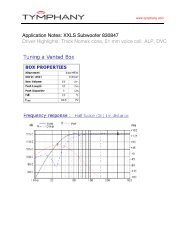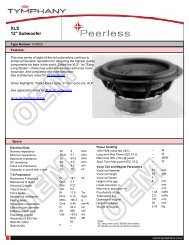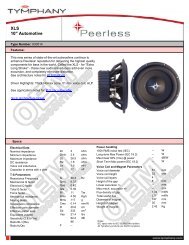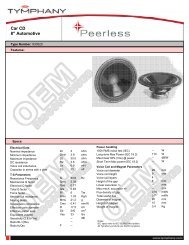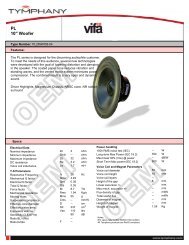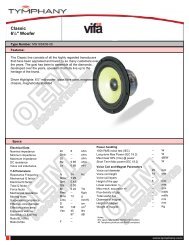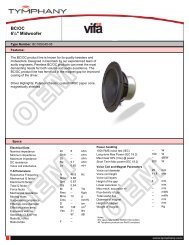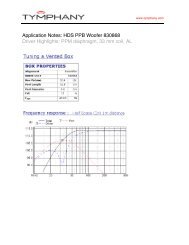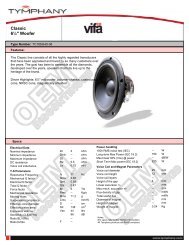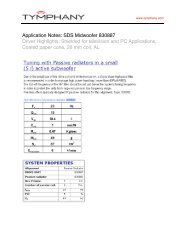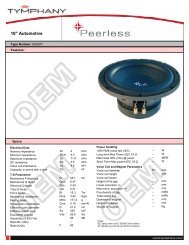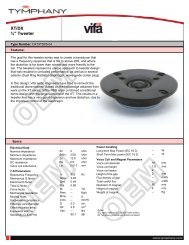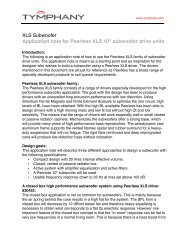An Improved Electrical Equivalent Circuit Model for ... - Tymphany
An Improved Electrical Equivalent Circuit Model for ... - Tymphany
An Improved Electrical Equivalent Circuit Model for ... - Tymphany
You also want an ePaper? Increase the reach of your titles
YUMPU automatically turns print PDFs into web optimized ePapers that Google loves.
Thorborg, Unruh, & Struck<strong>Improved</strong> <strong>Equivalent</strong> <strong>Circuit</strong> <strong>Model</strong>is regarded as part of the equivalent mass of the cone(M MS .). R E and L E are the resistance and the inductanceof the voice coil, C MS is the compliance of the totalsuspension and R MS represents the mechanical resistancein the system [1, 2]. <strong>An</strong> improved model of theelectrical impedance of the loudspeaker will bedeveloped and its impact on enclosure simulations willbe explored. The focus is on improvements to theelectrical side of the equivalent circuit, both to make themodel agree more closely with measurement, and tohave the elements in the model represent understoodbehaviour (physical modelling).in turn, sets up an electromotive <strong>for</strong>ce (i.e., e.m.f., orvoltage) equal to Bl . u , where u is velocity, that worksto oppose the velocity of the voice coil.The mechanical parameters are converted to virtualelectrical components by the equations shown below:C p= M MS(Bl) 2 (1)R p= (Bl)2R MS(2)L p= C MS⋅ (Bl) 2 (3)V= Bl ⋅u(4)Fig. 1 <strong>Equivalent</strong> circuit diagram <strong>for</strong> a loudspeakerusing the ’admittance’ analogy.2. IMPEDANCE2.1. Blocked and Motional ImpedanceThe electrical impedance of a loudspeaker, Z S (f) can beconsidered to consist of two parts, shown in the dashedboxes in Fig. 2.The subscript ‘P’ (parallel resonance circuit component)is used to designate the virtual electrical componentsaffecting the motional impedance.As shown in Fig. 2, the loudspeaker can be representedby a four-pole (two-port) electrical circuit. The circuitwill have a resonance frequency, f S , and at thatfrequency the electrical impedance will attain a localmaximum, Z 0 when 1/jωC P and jωL P cancel. However,in practice, very small residual reactive impedance dueto L E will move the measured resonance peak slightlyupwards in frequency. Since at resonance the motionalcomponent of the electrical impedance is equal to R P itfollows that:R= Z 0−(5)pR EFig. 2 <strong>Equivalent</strong> circuit diagram <strong>for</strong> a loudspeakerconverted to the electrical side.If the circuit shown in Fig. 1 is probed with a current i,then a voltage Bl . u will appear at the output terminals.If the frequency of the probing signal is f S , then u willbe maximized. Since the motional impedance is equal toR P , then:I ⋅ RpBl = (6)u maxThe components in the first box constitute the ‘blocked’impedance, which <strong>for</strong> small signals are independent ofthe motion of the speaker diaphragm. The componentsshown in the second box constitute the motionalimpedance. Motional impedance occurs when the voicecoil moves through the magnetic field of the motor. ThisAES 122st Convention, Vienna Austria, 2007Page 2 of 13
Thorborg, Unruh, & Struck<strong>Improved</strong> <strong>Equivalent</strong> <strong>Circuit</strong> <strong>Model</strong>u max could also be measured directly using a lasertransducer [3].2.2. Differences Between Measured and<strong>Model</strong>ed ImpedanceIt is not difficult to measure Z 0 , but as will be shownlater, R E is not exactly the same as R DC . It is alwaysslightly greater – with the consequence that Q ES (theelectrical Q-factor) is generally underestimated if R E isassumed to be the same as R DC . Previously, this hasbeen correctly attributed to eddy currents [3, 4]. For thesame reason, Bl, η, and SPL REF - the sensitivity at f S <strong>for</strong>Q TS = 1 (Q TS - the total Q-factor <strong>for</strong> the speaker) are alloverestimated when R E is assumed to be the same asR DC [1, 2]. Consequently, in this paper, we willdistinguish between R E and R DC . This will be discussedin more detail.The shape of the loudspeaker impedance function, Z S (f)is well known (see Fig. 3). Starting near R DC at very lowfrequencies, it is followed by a peak at the fundamentalresonance (of M MS and C MS ). Above the resonancefrequency, there is an anti resonance minimum at f min(primarily between L E and M MS /(Bl) 2 acting as a largecapacitor). Above this minimum, the impedanceaccording to the model should raise proportionally withfrequency.high frequencies is typically closer to 3 dB/octave ratherthan the 6 dB/octave we would expect if the onlyinductive element in the circuit were a conventionalinductor. Obviously, a box simulation based on thissimple equivalent circuit model will often result insignificant errors.2.3. Eddy Current Effects and Semi-InductanceVanderkooy [4] explains the 3 dB slope of theimpedance curve as the result of eddy currents in theiron core (of the speaker’s pole piece) and as the resultof the ‘skin effect’. As the skin depth decreases with thesquare root of frequency, the electrical conductivity ofthe iron in the pole piece is gradually reduced.Accordingly, the skin depth is∂ =2μσω(7)Here μ is the permeability and σ is the conductivity ofthe iron. If the coil and iron core were infinitely long –or in the case of a core in the <strong>for</strong>m of a closed magneticcircuit – it is shown (using Maxwell’s equations) thatthe coil will act as a “semi-inductor”, even at very lowfrequencies. The impedance of this semi-inductor iscalculated asZ = K ⋅ jω(8)Fig. 3 Typical loudspeaker impedance. Log ordinate(dB scale).Comparison between the impedance curve predicted bythe simple equivalent circuit and the actual measuredimpedance reveals some differences. First, at f min theimpedance magnitude should be very close to R DC , andthe phase angle should be close to zero. In practice,however, the impedance at f min is always higher thanpredicted. Typically <strong>for</strong> a woofer, the impedance isoften more than 1 dB higher and the phase is not zero.Secondly, the measured slope of the impedance curve atThis function will rise 3dB/octave as observed. Theunits of K are in ‘semi-Henrys’ [sH]. Due to the shortlength of the core and the very open structure of themagnet system, L E acts as an ordinary inductor at lowfrequencies, and typically becomes a semi-inductorabove 100-200 Hz. The low frequency inductance of theloudspeaker voice coil is only a few times higher thanits value in free air. This implies that the relativedifferential permeability is around 2, not around 3000 aswould normally be expected <strong>for</strong> iron. This is likely thereason <strong>for</strong> the unexpectedly high transition frequency,below which the skin depth is more thanr2 , where ris the radius of the pole piece. Vanderkooy did not try tomake an equivalent circuit model combining thesecomponents to include the transition from inductor tosemi-inductor – in a frequency range important <strong>for</strong>AES 122st Convention, Vienna Austria, 2007Page 3 of 13
Thorborg, Unruh, & Struck<strong>Improved</strong> <strong>Equivalent</strong> <strong>Circuit</strong> <strong>Model</strong>increase of more than 16%. If this extra resistance iseffective down to resonance (in this case, 32 Hz), it willhave a significant impact on the electrical damping, andconsequently also impact box simulation. To evaluate ifthis is the case, the blocked impedance was measured inthe frequency range around resonance. The resistancewas found to be 3.26 Ω and not 2.8 Ω. There<strong>for</strong>e, weconclude that it is more accurate to calculate the ThieleSmall parameters based upon R E = 2.8 + 0.46 = 3.26 Ω.This also generally confirms the need to distinguishbetween R E and R DC .4. DEVELOPING A NEW IMPEDANCEMODELFig. 6 shows a cross-section through a subwoofersimilar to the one used in the measurements. This driverhas an aluminium short-circuiting ring in the magnetsystem and an aluminium spacer on the pole piece tomaximize symmetry.If the iron core in the speaker were non-conductive, theresult would be a resistor R DC and an inductor L 0 ,considerably larger than the L E normally found <strong>for</strong> aloudspeaker (this has been proposed utilized to save thecost of the inductor in a cross-over network). Due to theconductivity of the core, we instead get a “trans<strong>for</strong>mer”with the n turns of the voice coil as primary and a ratherspecial “one turn secondary”’.4.1. Applying Trans<strong>for</strong>mer TheoryThe reason <strong>for</strong> this extra resistance is eddy currents.This can be shown by applying trans<strong>for</strong>mer circuittheory [5] explaining the discrepancy between themeasured and predicted values of the impedance in theearlier example. Mutual coupling between the voice coiland other components in the loudspeaker driver haspreviously been observed [6, 7, 8, 9].Fig.7 <strong>Equivalent</strong> circuit diagram <strong>for</strong> a trans<strong>for</strong>mer withturns ratio n:1 converted to primary side. ΔR = n 2. R SFig. 7 shows the equivalent circuit <strong>for</strong> a trans<strong>for</strong>merwith a turns ratio of n:1 shown with the secondaryshort-circuited, secondary winding resistance R S andconverted to primary side as ΔR. L EP and L ES are primaryand secondary leakage inductances (the secondaryconverted to primary side). L ES ' is L ES converted to theprimary side.Fig.6 Cross-section of a subwoofer. Effectively, atrans<strong>for</strong>mer is created with the voice coil (B) as theprimary and all of the conducting material around thevoice coil as a one-turn secondary. Note the aluminiumshort- circuiting ring (D) and pole extension (A).The same equivalent circuit is applicable <strong>for</strong> the blocked“speaker trans<strong>for</strong>mer” at low frequencies, where theskin depth is equal to the pole radius. The resistance ofthis secondary converted to the primary side is now ΔRand the secondary leak inductance converted to theprimary side is L ES . For this ‘trans<strong>for</strong>mer’, the lower cutoff frequency occurs where the impedance ωL 0 equalsΔR. Below this frequency, the impact of ΔR becomesnegligible as the impedance goes asymptotic towardR DC. Above this very low frequency, the impact of L 0 , isnegligible, so the total effective resistance R E actuallybecomes the sum of ΔR and R DC . This higher value hassignificant impact when used to calculate the Thiele-Small parameters. Above the cut off, frequency, theAES 122st Convention, Vienna Austria, 2007Page 6 of 13
Thorborg, Unruh, & Struck<strong>Improved</strong> <strong>Equivalent</strong> <strong>Circuit</strong> <strong>Model</strong>primary and secondary leakage inductances are simplyadditive.The primary leakage inductance in a trans<strong>for</strong>merrepresents the part of the flux from the current in theprimary winding not enclosed by the secondary – andvice versa. The tighter the coupling between thewindings, the less leakage inductance is observed. So,thicker insulation between the windings results in moreleakage inductance. The trans<strong>for</strong>mer analogy shows usthat the traditional loudspeaker L E is in fact the sum ofthe two ‘leakage inductances’.Part of the primary leakage in the “speaker trans<strong>for</strong>mer”is due to the “overhung” part of the voice coil. Not allflux from the current through this section finds its waythrough the pole piece. <strong>An</strong>other cause of leakage is thespacing between the coil and the conductive pole piece,which acts like the insulation between the windings in atrans<strong>for</strong>mer. The inductor L EB represents thesecomponents in the proposed equivalent circuit.There is an additional and more significant source ofleakage inductance. At low frequencies, the “skindepth” is equal to the radius of the pole piece. Eddycurrents are distributed over the cross section of the polepiece. The current in the outermost part of the polepiece will enclose most of the AC flux through the polepiece. However, as the depth increases into the crosssection of the pole piece, the current will enclose lessand less of the flux from the voice coil current. Arigorous analysis of the distribution of flux and eddycurrents can be examined by Finite Element <strong>An</strong>alysis.However, it is sufficient here to point out that not all ofthe primary flux through the pole piece is enclosed byall of the secondary current (eddy currents in the polepiece) and that this is the most significant source ofleakage inductance. L E ’ is caused by primary flux notenclosed by the secondary current and is bestrepresented as an additional primary leakageinductance. Remember, however, that except at verylow frequencies, contributions from the primary andsecondary side are simply additive. As long as the “skindepth” is greater than r / 2 (where r is the radius ofthe pole piece), the distribution of flux and current isnearly constant, and consequently the resultantresistance and leakage inductance are also nearlyconstant. But as the skin depth diminishes, ΔR andjωL E ’ both increase as a function of ω. At the sametime, the leakage inductance L E ’(ω) decreases with ω asthe current in the progressively thinner conductive layerencloses an increasingly greater part of the AC fluxthrough the pole piece. This explains in principle thebehaviour as predicted by Vanderkooy [4]. Around thetransition frequency, ΔR + jωL E ’ gradually changesfrom constant values <strong>for</strong> ΔR and L ES to K E⋅ jω.For model simplicity, ΔR is added to R E , althoughclearly this is not absolutely correct. Keep in mind,however, that the goal here is to have a model that isboth accurate and ‘practical’, i.e., not significantly morecomplex than absolutely necessary. Also note that thisapproximation has no significant negativeconsequences, as ΔR rapidly becomes a less significantpart of K E with increasing frequency. For practical use,L 0 can usually be neglected, so the circuit shown Fig. 4can be used with R E = R DC + ΔR, where R E isdetermined by iteration or curve fitting. The exact fit iscritical in the frequency range up to f min .To find the transition frequency <strong>for</strong> the example speakerbetween ΔR (0.46 ohm) and L 0 , we seek the frequencywhereωL 0= ΔR (23)At this frequency the blocked impedance is close tobeing purely resistiveR E= R DC+ ΔR 2(24)In this example, the frequency was found to be atapproximately 10 Hz, corresponding to an L 0 of 7.5 mH.The relative differential permeability is then about 3 andthe transition frequency <strong>for</strong> semi-inductor behaviourshould be expected to be around 27 Hz. The bestmethod <strong>for</strong> deriving L 0 is using a curve fit, which willbe described later.4.2. Complete Practical Impedance <strong>Model</strong>The total equivalent circuit diagram <strong>for</strong> the improvedimpedance model is shown Fig. 8. [10]AES 122st Convention, Vienna Austria, 2007Page 7 of 13
Thorborg, Unruh, & Struck<strong>Improved</strong> <strong>Equivalent</strong> <strong>Circuit</strong> <strong>Model</strong>RZ E,Total= Z E,Blocked+ ( Bl) 2 z m(25)R DCL EBL EL 0K E...Bl:1...where Z m is the mechanical mobility of the transducer,representing all of the circuit load to the right of thetrans<strong>for</strong>mer shown in Fig. 8 [1, 10].V G5. VERIFICATION OF THE NEW MODEL5.1. Measurements and Curve FittingFig. 8 New electrical equivalent circuit model.The elements in this equivalent circuit are:V GR DCapplied open circuit voltageDC resistance of the voice coilA PC-based data acquisition system (Listen, Inc.SoundCheck) was used to measure the blockedimpedance of a subwoofer at 1/12-octave intervals from10 Hz to 20 kHz. The data were fit to the model usingthe Solver function in Microsoft Excel. When desired,introducing a high strength adhesive between the voicecoil <strong>for</strong>mer and the pole piece of the drivers eliminatedvoice coil motion. This eliminated the effects of theback electro-motive <strong>for</strong>ce allowing the blockedimpedance to be examined without having to removethe motional component of the electrical impedance.BlL EBK Emotor <strong>for</strong>ce constantinductance of the part of the voice coil outsidethe motor gap“semi-inductance” term related to eddy currentand skin depth behavior in the motor, with theimpedance of this element representedmathematically by jωK EThe subwoofer tested was a 10” Peerless XXLS model830843. This woofer features an aluminium spacer onthe pole piece and an aluminium short circuiting ring.Table 1 shows the parameters used to fit the data to thecircuit shown in Fig. 4. Fig. 9 shows the measuredimpedance magnitude and the curve fit based on theparameters in Table 1. Fig. 10 is similar, but shows thephase. This curve fit was based upon data taken with ablocked voice coil.L EL 0∆Rinductance of the part of the voice coil locatedinside the motor gapinductance representing the coupling of the coilto the motoreddy current losses in the motorParameter Value UnitsR E 6.19 ohmsL EB 0.315 mHTogether, L 0 and ∆R represent that part of the lowfrequency behavior of the motor, in which the voice coilcouples to the motor as if the motor were a single-turnresistive coil, and in which the skin depth is large. TheK E term, on the other hand, represents the higherfrequency behavior of the motor, in which the skindepth is small [10].K E 0.134 Semi-HenrysL E 2.29 mHTable 1. Peerless 830843 Blocked impedanceparameters. Fit to the circuit shown in Fig. 4.The total electrical impedance isAES 122st Convention, Vienna Austria, 2007Page 8 of 13
Thorborg, Unruh, & Struck<strong>Improved</strong> <strong>Equivalent</strong> <strong>Circuit</strong> <strong>Model</strong>Impdance Magnitude, 80dB~8 ohm100959085807570CalculatedMeasured10 100 1000 10000 100000Frequency [Hz]Fig. 9 Measured magnitude data and curve fit of theblocked impedance of the Peerless 830843.Parameter Value UnitsR E 6.29 ohmsL EB 0.319 mHK E 0.133 Semi-HenrysL E 2.38 mHC P 0.442 μFR P 114 ohmsL P 86.4 mHTable 2. Peerless 830843 parameters. Blockedimpedance fit to simplified circuit shown in Fig. 4. Unitwas measured in free air.908070Fig. 11 shows the measured impedance magnitude andcurve fit based on the parameters in Table 2. Fig. 12shows the phase.60CalculatedMeasuredPhase, degrees5040110105Calculated30100Measured2010010 100 1000 10000 100000Frequency [Hz]Fig. 10 Measured phase data and curve fit, blockedimpedance – Peerless 830843.Impedance Magnitude 80 dB~8 ohm95908580757010 100 1000 10000 100000As evidenced by Figs. 9 and 10, the curve fit is inexcellent agreement with the measured data. Theartifact found around 4 kHz in the measured data is theresult of a mechanical resonance in the blocked system.Frequency [Hz]Fig. 11 Measured magnitude data and curve fit,Peerless 830843. Impedance fit to the simplified circuitshown in Fig. 4. Unit was measured in free air.It is advantageous to be able to measure the blockedimpedance parameters of a driver in a non-destructivefashion. To this end, the free air impedance of thedriver was measured and curve fit to the ‘simplified’blocked impedance model shown in Fig. 4. Themotional component of the electrical impedance was fitusing L P , R P , and C P as discussed in Section 2.1. Table2 shows the parameters used to fit the blockedimpedance data.AES 122st Convention, Vienna Austria, 2007Page 9 of 13
Thorborg, Unruh, & Struck<strong>Improved</strong> <strong>Equivalent</strong> <strong>Circuit</strong> <strong>Model</strong>9070503010-10-30-50Calculat edM easur edresult of a rim resonance in the speaker’s rubbersurround.Next, the data obtained by measuring the 830843 in freeair was used to fit the ‘complete’ blocked impedancemodel shown in Fig. 8. Table 3 shows the results of thiscurve fit. Fig. 13 shows the measured impedancemagnitude and the curve fit based on the parameters inTable 3. Fig. 14 is similar, but shows the phase.-70-9010 100 1000 10000 100000110Fr equency [Hz]Fig. 12 Measured phase data and curve fit, Peerless830843. Impedance fit to the simplified circuit shown inFig. 4. Unit was measured in free airImpedance Magnitude, 80dB~8 ohms10510095908580CalculatedMeasuredParameter Value UnitsR DC 5.83 ohmsL EB 0.307 mHK E 0.138 Semi-HenrysL E 2.24 mH757010 100 1000 10000 100000Frequency [Hz]Fig. 13 Measured magnitude data and curve fit,Peerless 830843. Impedance fit to the complete circuitshown in Fig. 8. Unit was measured in free air.9070L 0 10.8 mH5030CalculatedMeasured∆R 0.540 ohmsC P 0.445 μFR P 116 ohmsL P 86.0 mHPhase, degrees10-10-30-50-70-9010 100 1000 10000 100000Frequency [Hz]Table 3. Peerless 830843, parameters. Impedance fitto the complete circuit shown in Fig. 8. Unit wasmeasured in free air.Again, the curve fit and the measured data are inexcellent agreement showing that the voice coil does notneed to be held motionless to accurately measure theblocked impedance parameters. Note that the blockedimpedance parameters shown in Tables 1 and 2 showgood agreement. The artifact found around 600 Hz inthe measured data shown in Figs 11 through 14 is theFig. 14 Measured phase data and curve fit, Peerless830843. Impedance fit to the complete circuit shown inFig. 8. Unit was measured in free airCompared to the data shown in Table 2, the data givenin Table 3 produces a slightly better curve fit althoughthe improvement is too small to be easily seen in thefigures. The values <strong>for</strong> L EB , K E , and L E are not stronglydependent upon which model is used – simplified orcomplete. In addition, these data show that it is notnecessary to eliminate voice coil motion to measure theAES 122st Convention, Vienna Austria, 2007Page 10 of 13
Thorborg, Unruh, & Struck<strong>Improved</strong> <strong>Equivalent</strong> <strong>Circuit</strong> <strong>Model</strong>blocked parameters as they can easily be derived fromthe free air impedance.6. DISCUSSIONFrom a trans<strong>for</strong>mer point of view, the “speakertrans<strong>for</strong>mer” is very special. The pole piece is a ratherpoor quality iron core <strong>for</strong> a trans<strong>for</strong>mer, and in fact thiscan be a significant cause of nonlinear distortion,particularly as the core is pre-magnetized. In a realtrans<strong>for</strong>mer, the core is either non-conductive orlaminated to avoid eddy currents. However, in aloudspeaker, eddy currents actually provide a benefit bylowering the impedance rise due to inductance andextending the frequency range significantly at higherfrequencies. This also provides extra power handling tothe speaker, as some of the power is conducted to the“secondary winding”, heating the pole piece and not thevoice coil [4]. Often, conducting material is introducedclose to the coil in the <strong>for</strong>m of aluminium (or copper)short circuiting rings inside the magnet system and/or acopper cap upon the pole piece to give betterconductivity to the “single turn” secondary. Theintended result is more output at higher frequencies,better power handling, and reduction of the ACmagnetization of the pole piece, which in turn reducesdistortion. By careful dimensioning it is possible notonly to reduce the voice coil induction, but also tominimize its dependency on actual position. In this way,a primary cause of distortion in loudspeakers is reduced.The impact of eddy currents in a copper cap, magneticshort-circuiting rings, and/or Cu/Al pole pieceextensions will depend on how tightly they couple to thevoice coil and the resistance they represent converted tothe “primary” side. For a short-circuiting ring or polepiece extension, this is most often on the same order ofmagnitude as R DC , however, the coupling is not verytight. With respect to the equivalent circuit, this meansthat K E || L E will be shunted with a rather large ‘leakageinductance’ in series with a resistor much larger thanΔR. As the voice coil still couples to the iron pole pieceinside the air gap, the main effect is a slight reduction ofZ min and a reduction of K E . Of course, the mostimportant effect of the short-circuiting ring (with carefuldimensioning) is reducing the L E dependency on coilposition – or at least making it more symmetric – andconsequently reducing distortion.in the air gap, it is generally as thin as 0.3 mm, andthere<strong>for</strong>e shunts K E || L E in the model with a very lowleakage inductance in series with a large resistor. Thiseffect can be observed as a rather flat impedance curveabove a frequency where K E is equal to this resistance.In general, loudspeakers having conducting rings in themagnet system still exhibit some semi-inductorbehaviour in the impedance. However, K E is reducedcompared to same speaker without the conducting ring.The remaining semi-inductor effect must be due to thepart of the coil inside the top plate, in close contact withmagnetic conducting material both inside and around it(pole piece and top plate). It was found that the newequivalent circuit was also able to model speakers withconductive rings and copper caps.The new equivalent circuit described here has alreadybeen successfully used to model the electricalimpedance behaviour of the <strong>Tymphany</strong> Linear ArrayTransducer, and to determine the device’s Thiele-Smallparameters [10]. In this case, the curve fitting wasper<strong>for</strong>med only on the amplitude, neglecting phase, asthe functions are assumed to be “minimum phase”. Thisis the case as the equivalent circuit model is built up ofsimple passive components (e.g., resistors, inductorsand capacitors). Even the semiconductor can beconsidered minimum phase, as it might be thought of asconstructed of a series of shunt connections of inductorsand resistors.It should also be noted that the computer programmeLspCAD, version 6.32, has been updated to handle theimproved equivalent circuit model described here. Notethat the model used in this programme includes anadditional shunt resistor to L EB not included in theequivalent circuit model described here. To <strong>for</strong>ce theprogramme to use the circuit model as exactly asdescribed here, simply give this element a very highvalue to eliminate its effect. More in<strong>for</strong>mation aboutthis programme is available at: http://www.jidata.com. Asimulation using this program is shown Fig. 12.A copper cap on the pole piece – and particularly in theextended “symmetric drive” version [15] – couples verytightly to the voice coil. However, as this takes up spaceAES 122st Convention, Vienna Austria, 2007Page 11 of 13
Thorborg, Unruh, & Struck<strong>Improved</strong> <strong>Equivalent</strong> <strong>Circuit</strong> <strong>Model</strong>[10] A. Unruh, C. J. Struck, et al, “<strong>An</strong> Extended SmallSignal Parameter Loudspeaker <strong>Model</strong> <strong>for</strong> theLinear Array Transducer” presented at the AES121 st Convention – San Francisco, CA (2006October).[11] K. Ougaard, “UniBox”.[12] R. H. Small, “Vented-Box Loudspeaker SystemsPart I: Small-Signal <strong>An</strong>alysis”, J. Audio Eng. Soc.,Vol. 21, No. 5 (1973 May).[13] A. Unruh, C. J. Struck, “Linear Array TransducerTechnology”, presented at the AES 121 stConvention – San Francisco, CA (2006 October).[14] W. Klippel, “Tutorial: Loudspeaker Nonlinearities– Causes, Parameters, Symptoms”, J. Audio Eng.Soc., Vol. 54, No. 10 (2006 October).[15] R.Lian, “Distortion Mechanism in theElectrodynamic Motor”, presented at the 84 th AESConvention – Paris (1988 March)AES 122st Convention, Vienna Austria, 2007Page 13 of 13



